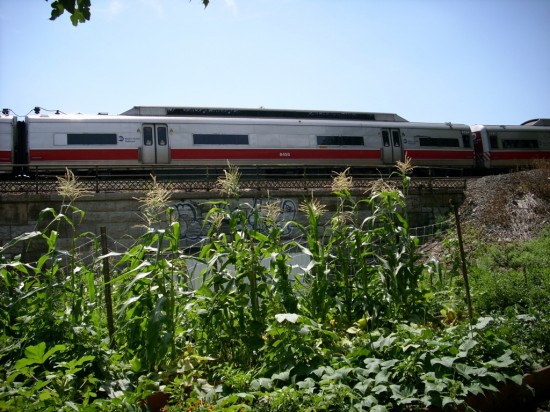
Mott Haven and Melrose gardeners say they preserve rare green space
Mott Haven and Melrose are home to about two-dozen community gardens, lovingly tended green spaces tended by residents, who plant and harvest food and flowers, play music, exercise or simply kick back under stately shade trees.
With names like United We Stand, La Finca del Sur and La Casa de Chema, some recall the Puerto Rican countryside with their casitas, miniature wooden huts where friends gather for conversation.
Most are on land owned by the city, and were left to gather trash and breed vermin before they were reclaimed by residents. Now, local gardeners and their counterparts citywide fear the city wants them back for development.
Carlos Torres, who runs Vogue Community Garden, a pint-sized park with a few raised beds and a casita on 155th St. between Elton and Melrose avenues, used to oversee a garden four times the size next door.
Three years ago, the city’s Department of Housing Preservation and Development sold the land to a developer, and now an apartment complex towers over the little pocket park Torres and others negotiated to salvage.
Still, Torres thinks he made out alright, and that the garden is safe now. He and others grow eggplants, tomatoes, carrots, bell peppers and hot peppers. In their larger garden, they had cherry trees, peach trees, raspberries, strawberries and apple trees, but those are gone.
“Finally, I got the corner,” he said. “I can’t plant the way I used to, but I’m content. They can’t move us.”
A mile or so south of Vogue, La Finca del Sur is a relative newcomer among local community gardens. La Finca, which is open to the public Fridays through Sundays, sits on a triangular three-acre lot, fenced off from E. 138th St. at the southern end of the Grand Concourse, flanked by elevated train tacks and an exit ramp off the Major Deegan Expressway. Cars and Metro-North trains race past. The entrance to the 4 and 5 subway line sits across the street, while Park Avenue a block away boasts a taxi garage and a strip club.
“They used to come in through the back from Sin City, the strip club, and walk right across here to get to the trains,” lifetime Bronx resident Nancy Ortiz-Surun, the garden’s unofficial steward, wryly recalled while tending to one of the raised vegetable beds. “This is not your typical garden,” she added.
Twelve residents plant at the year-old garden, which is operating this year on a budget of $12,000 from grants and private funding sources. Tools are kept in a former rail car Ortiz-Surun found on Craig’s List. The barrel that catches rainwater for irrigation was a New York Botanical Garden throwaway.
Ownership of the land is divided between the Parks Department and the MTA. In case of a subway emergency, riders would emerge from underground through rusted grates between the raised beds.
Given its location in the crosshairs of a transportation bulls-eye, the threat of any sort of real estate takeover by the city would appear unlikely, but Ortiz-Surun remains leery. “This is a bridge and tunnel location,” she said. “We could be threatened,” she added, but then said, “I’m not sure the powers that be know we’re here.”
Farther east on 137th Street between Cypress and Brook Ave, United We Stand offers cool summer breezes away from the stifling heat that surrounds it. Connected with two other gardens, Girasol and St. Luke’s Garden, United We Stand’s patrons have been relishing the shade and the veggies since the 1970s.
The lot was nothing more than an overgrowth of weeds on cracked pavement 30 years ago, says Jose Ramos, 82, one of a half-dozen Puerto Rican Mott Havenites who have nurtured the garden from urban neglect to quasi-rural leisure.
“It belonged to the city, but then we got involved,” said Ramos in Spanish, an ironic smile stealing across his leathery face. “Most of us are old,” Ramos said. “We suffered a lot at first when the trees were small, and we killed ourselves hauling bricks.”
“Any decent person can come and get food,” Ramos said, emphasizing that people don’t have to tend plots in the garden to share the harvest. “We are as if one person.”
A version of this story appeared in the Summer 2010 issue of the Mott Haven Herald.

[…] Bronx Farmers Market is in its second season and has partnered with Mott Haven community garden La Finca del Sur to sell the locally grown produce that residents like Betancourt appreciate but have rarely had […]